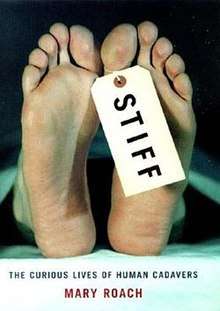Stiff: The Curious Lives of Human Cadavers
Stiff: The Curious Lives of Human Cadavers is a 2003 non-fiction work by Mary Roach. Published by W. W. Norton & Company, it details the unique scientific contributions of the deceased.
 | |
| Author | Mary Roach |
|---|---|
| Country | United States |
| Language | English |
| Subject | Science, death |
| Genre | Non-fiction |
| Publisher | W. W. Norton & Company |
Publication date | 2003 |
| Media type | Hardback |
| Pages | 304 |
| ISBN | 0-393-32482-6 |
| OCLC | 55230887 |
In the book, Roach gives firsthand accounts of cadavers, a history of the use of cadavers, and an exploration of the surrounding ethical/moral issues. She places each chapter's content into a historical context by discussing the history of the method of using a cadaver she is about to witness.
Stiff was a Best Seller, a 2003 Barnes & Noble Discover Great New Writers pick, and one of Entertainment Weekly's Best Books of 2003. It also won the Amazon.com Editor's Choice award in 2003, was voted as a Borders Original Voices book, and was the winner of the Elle Reader's Prize.[1] Stiff has been translated into 17 languages, including Hungarian (Hullamerev) and Lithuanian (Negyvėliai).[2] Stiff was also selected for Washington State University's Common Reading Program in 2008-09.[3]
The Author: Mary Roach
Born and raised in New Hampshire, Mary Roach partook in wild activities such as riding a ski-doo and using a rifle. She graduated from Wesleyan University in Connecticut with a degree in psychology, and decided to move after graduating to the opposite side of the country: San Francisco, California.
After writing updates about the animals and their ailments (she writes “denying rumors the cheetahs had been sucked dry by fleas”) for the San Francisco Zoo, she discovered her passion and dedicated her time to making posts for the Sunday paper. Her talent was recognized and she had posts in multiple top newspapers such as National Geographic, The New York Times, and Vogue. Her first published book was Stiff. Although most of her works focus on science, she admits she does not have formal education in the sciences but enjoys it most.
Topics covered
The book covers 12 topics:
- Practicing cosmetic surgery on cadaver heads
- Body snatching and the early years of human dissection
- The nature of decomposition
- Cadavers for use as crash test dummies
- Using cadavers to analyze a crash site
- Army tests on cadavers
- Crucifixion experiments
- Beating heart cadavers, the soul, and being buried alive
- Decapitation and human head transplant
- Cannibalism in the name of medicine
- New alternatives to burial and cremation
- The author's views on her own remains
References
- Roach, Mary. "Stiff: The Curious Lives of Human Cadavers". Retrieved 21 July 2012.
- Roach, Mary. "Mary Roach". KQED. p. KQED Arts. Retrieved 21 July 2012.
- Pullman (12 September 2008). "WSU News Center". WSU News Center. Archived from the original on 15 December 2012. Retrieved 22 July 2012.
External links
- Mary Roach's website
- Stiff book page on the publisher's (W.W. Norton & Company) website
- Roach talks about Stiff on NPR
- "Book Discussion on Stiff: The Curious Lives of Human Cadavers". C-SPAN. 22 April 2003. Retrieved 18 April 2015.
Mary Roach talked about her book Stiff: The Curious Lives of Human Cadavers, published by W.W. Norton. She discussed the many ways in which the deceased benefit the living. The book explores the “lives” of cadavers from the time of the ancient Egyptians, to the anatomy labs of medieval and nineteenth-century Europe, to the current campaigns for human composting in Sweden. According to Ms. Roach, for more than two thousand years, dead bodies have been involved in scientific research. They tested France’s first guillotines, traveled aboard the NASA Space Shuttle and assisted in creating new surgical procedures such as heart transplants and cosmetic surgery. After her remarks the author answered audience members' questions.